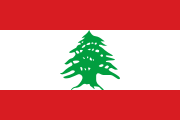| الجمهورية اللبنانية
|
al-Ǧumhūriyya al-lubnāniyya
|
| Libanesische Republik
|
|
| Amtssprache | Arabisch |
| Hauptstadt | Beirut |
| Staatsform | parlamentarische Republik |
| Regierungssystem | parlamentarisches Regierungssystem |
| Staatsoberhaupt | PräsidentMichel Aoun |
| Regierungschef | MinisterpräsidentHassan Diab |
| Fläche | 10.452 km²
|
| Einwohnerzahl | 6.100.075 (Juli 2018, geschätzt)[1] |
| Bevölkerungsdichte | 583 Einwohner pro km²
|
| Bevölkerungsentwicklung | ▲ +0,84 % (2016)[2] pro Jahr
|
Bruttoinlandsprodukt- Nominal
- Total (KKP)
- BIP/Einw. (nominal)
- BIP/Einw. (KKP)
| 2018[3]- 56,4 Milliarden $ (82.)
- 89,5 Milliarden $ (91.)
- 9.251 $ (76.)
- 14.689 $ (91.)
|
| Index der menschlichen Entwicklung | ▲ 0,757 (80.) (2017)[4] |
| Währung | Libanesisches Pfund (LBP)
|
| Unabhängigkeit | 22. November 1943
(von Frankreich)
|
| Nationalhymne | Kullunā li-l-watan li-l-ʿulā li-l-ʿalam |
| Nationalfeiertag | 22. November
|
| Zeitzone | UTC+2
UTC+3 (März bis Oktober)
|
| Kfz-Kennzeichen | RL |
| ISO 3166 | LB, LBN, 422
|
| Internet-TLD | .lb |
| Telefonvorwahl | +961
|
|



